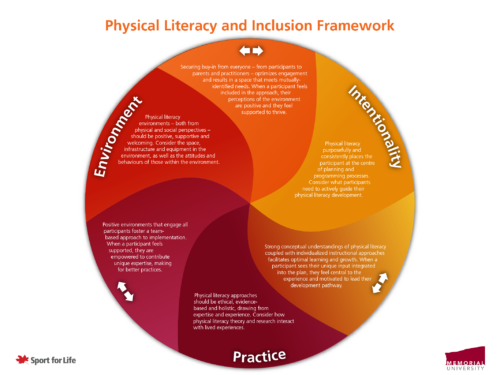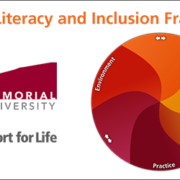Pillars to physical literacy and inclusion: Environmental compatibility between physical and social elements
Many programs have implemented physical literacy (PL) but often overlook the experiences of persons with diverse abilities due to societal, cultural, and political influences. This can lead to exclusion and marginalization from physical activities. Researchers at Memorial University have addressed this challenge by developing a PL and inclusion framework through direct observation of programming and perspectives from participants of diverse abilities, parents, practitioners, and program administrators. The framework and its three pillars of environment, practice and intentionality offer one lens to support the development of current and future inclusive physical literacy programs.

This blog series will discuss the ten evidence-based best practices for the inclusion of persons with diverse abilities in programming suggested within their research findings. From holistic design to systems of support, and everything in between, find out how to foster inclusion in your programs.
Idealization: Ensure environmental compatibility between physical (infrastructure, equipment, space) and social (attitudes and behaviours) contextual elements at an individualized level.
The environment pillar emphasizes the importance of creating a positive and supportive environment that promotes physical literacy for everyone. This includes the community, stakeholders, and the physical infrastructure. To ensure inclusive development of physical literacy, it is necessary to involve and get support from various stakeholders such as participants, parents, practitioners, and administrators. When they actively participate, and the physical context is welcoming, it creates an environment where participants can thrive and succeed.
A team-based approach to programming is also essential to facilitating physical literacy development for all. Use the expertise of those involved to create a more informed approach. Stakeholders are ‘knowledge-holders’ whose perspectives are of equal value.
Putting into practice
Meet Emily, a certified fitness trainer passionate about promoting inclusive physical activity. She has a new client, Mark, who has a mobility impairment due to a spinal cord injury. Emily is committed to ensuring that Mark can engage in physical activity for the long term while feeling comfortable and supported.
Emily starts by conducting a thorough, personalized assessment of Mark’s physical capabilities and limitations. She considers his mobility level, muscle strength, range of motion, and any adaptive equipment he may need. Emily designs a customized workout plan that caters to Mark’s specific needs. In addition to simple bodyweight exercises, she also ensures that any exercise equipment is adaptable, such as resistance bands for upper body workouts and accessible weight machines that accommodate his mobility impairment.
Emily also recognizes the importance of creating a welcoming and inclusive environment. She ensures that her other clients know Mark’s condition and the importance of being supportive and respectful. Emily briefly meets with her group fitness class, where she introduces Mark and educates them on basic disability etiquette and inclusion. She encourages open communication and emphasizes the importance of creating a judgment-free atmosphere.
During Mark’s training sessions, Emily constantly monitors his progress and adjusts exercises and techniques to match his evolving capabilities. She actively seeks Mark’s feedback to understand his comfort levels and preferences. Emily incorporates a mix of aerobic, strength, and flexibility exercises into Mark’s routine, allowing for variety and progress. She uses clear verbal instructions and tactile cues to guide Mark through movements safely. She also offers alternative exercises when necessary.
Over time, Emily observes significant improvements in Mark’s strength, mobility, and confidence. Mark not only achieves his fitness goals but also begins participating in group classes alongside his training sessions. Emily continues to support him on his journey, ensuring that he remains engaged in physical activity for the long term.
By addressing both physical and social compatibility and tailoring her approach to meet Mark’s individual needs, Emily has created a successful and inclusive fitness environment. Mark’s positive experience and continued engagement in physical activity demonstrate how a dedicated practitioner can significantly impact an individual’s long-term well-being.
Tangible takeaways
Here are some suggestions, adjustments and additions you can make to your program environment or facilities to support participants with diverse abilities. This is not an exhaustive list, but will support in taking some initial steps within your organization or program:
- Ensure physical accessibility by removing barriers such as steps, narrow doorways, and inaccessible restrooms. Install ramps, elevators, and handrails.
- Provide alternative formats for information and materials, such as braille, large print, audio, or digital formats.
- Make sure venues and spaces are well-lit and have clear signage.
- Use assistive technologies, such as hearing loops or captioning systems, to accommodate participants with hearing impairments.
- Provide individualized support and accommodations based on the specific needs of participants. This may include assistive devices, modifications to activities, or additional assistance from staff or volunteers.
- Think about ways you can use different pieces of equipment in activities, to support the diverse abilities of each participant (e.g., various sizes, colours, textures, etc. of equipment).
- Use clear and concise language when communicating with participants.
- Allow for different modes of communication, such as sign language interpreters or communication boards.
- Be patient and give individuals extra time to express themselves or respond.
- Use inclusive language that focuses on abilities rather than disabilities.
- Make your organization’s website as accessible as you can! Offer online accessibility settings like adjustable fonts, font size, website colours, etc.
This article is one of a series of posts on the Sport for Life website based on the research conducted by Drs. Kyle Pushkarenko and Jeff Crane of Memorial University. Keep an eye on our blog for information on the ten suggested best practices and ways to take action around them over the coming months.

